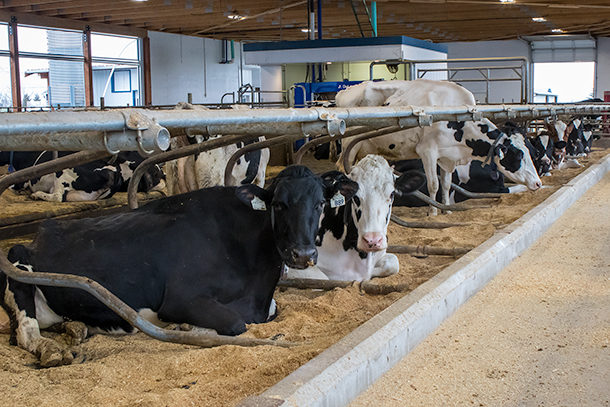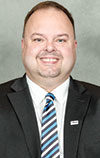This is the third of three articles in the “Flipping Your Freestalls” series. Read Part I and Part II.
More on a brisket locator
The brisket locator keeps the cow from moving forward while resting and helps position the cow in the stall and preserves forward lunge space. It also provides a bracing point for cows as they get up. When positioned properly, the brisket locator provides all cows with ample space to lie down comfortably within the stall. The brisket board is positioned directly underneath the neck rail or slightly further toward the rear of the stall. In deep-bedded stalls, it is important to measure from the inside of the curb.
The best brisket locator is one that provides the cow with an opportunity to extend her front legs over the locator while resting. Cows often extend their front legs over the brisket locator while resting. To allow for this behavior, a brisket locator with rounded edges is preferred over sharp or straight edges. Flexible plastic barriers with rounded edges (i.e., PVC pipes) generally perform best. Four-inch Schedule 40 PVC pipes work well.
When the brisket board is placed too close to the curb, diagonal resting may occur. If cows do not have enough space to lie down because the brisket board is too far back, hock injuries may be observed. Moreover, this situation can lead to perching, just as an improperly placed neck rail does. If the brisket locator is placed too far forward, cows may become trapped while rising from the stall. Additionally, excessive manure and soil may be deposited in the rear of the stall. If the brisket board extends more than 6 inches above the stall surface, it may block forward lunging as cows rise from the stall and prevent them from extending their front legs forward during the rising motion. Abrasions on the inside of the cows’ front legs may be observed if the brisket board is too high or has rough edges. If the existing brisket locator impedes forward lunge space or does not provide a smooth surface for the cow to extend her legs over, the existing brisket locator may need to be removed and replaced with a smooth brisket locator no more than 4 to 6 inches above the stall surface. It may be possible to shorten the existing wood brisket board to the desired height, but care must be taken to avoid rough edges.
Tip 1: Replace or fix dividers and loops
Often, the first step to renovating a freestall barn is to fix what is broken in the existing barn. All too often, cow comfort is compromised by broken or detached freestall dividers and stall structures. Not only can these stalls lead to sub-optimal stall use, but they also can result in serious injuries. Reattaching or repairing stall dividers and structures is a simple step toward improving cow comfort. Sometimes, the best idea is to replace the existing stall dividers with new or slightly used stall dividers that may be more conducive to increased stall use. Loops that provide an opportunity for side lunging are preferred. Newer divider designs are often more flexible than rigid, traditional designs. There may be advantages to these more flexible dividers for cow comfort, but caution should be used to make sure they do not provide too much flexibility. In some cases, these loops may be flexible enough to encourage diagonal lying to the point that cows may even occupy one and a half stalls, which eliminates space for another cow.
Tip 2: Improve natural ventilation
During warmer temperatures, poor ventilation may result in cows expressing obvious signs of heat stress (i.e., panting, breathing heavily). When temperatures are cooler, poor ventilation can result in increased respiratory problems and transmission of diseases. Lack of proper ventilation can lead to high moisture levels, manure gases, pathogens and dust concentrations, which create an adverse environment for dairy cows. For optimal production and well-being, dairy cows should be provided with a constant supply of fresh, clean air. Frequently exchanging air removes or reduces the concentrations of dust, gases, odors, airborne disease organisms and moisture. Maximizing natural ventilation is the first step toward improving ventilation. Natural ventilation relies on barn openings and orientation to remove heat and humidity from the animals’ environment.
Exhausted air generally leaves the barn through sidewalls or ridge openings. Although old barn designs suggested closed-in barns, current recommendations are to open the barns up to allow for better air exchange. Sidewalls allow air, heat and humidity to be easily and continuously removed from the barn. This is particularly critical during the summer. If producers are concerned about the potential negative effects of open sidewalls during the winter, sidewall curtains, which can be raised in the summer and lowered during the winter, may be added to eliminate this concern. A ridge opening should also be provided at the top of the building to facilitate air removal through the top of the barn. Warm, moist air rises and exits through the ridge opening even on calm days. Adding or increasing the size of the ridge opening can dramatically improve natural ventilation. The ridge opening should be at least 3 inches for each 10 feet of building width. Producers are often resistant to this change because of fears of precipitation entering the barn through the ridge opening. Although this is generally not a major problem, a ridge cap may be added to eliminate this concern. If a cap is placed above the ridge, the distance between the roof and the cap should be ¾ of the ridge opening. Often, this cap is placed so close to the roof, it defeats the purpose of the ridge opening by choking air through the cap.
The steeper the roof slope the better the movement of the warm, moist air out of the ridge vent. The roof slope should be at least 3/12: 3 inches of rise for every 12 inches of run. A slope of 4/12 is preferred. For many older barns with ventilation issues, the main opportunity for improvement is removing tin or wood sidewalls that block natural winds from entering the barn. Before removing these obstructions, consider how this change might affect the structural integrity of the building. Strive for at least 8 feet of sidewall opening. A 3- to 4-foot overhang should be provided to prevent precipitation from entering the barn. Curtains may be needed to block adverse weather during the winter. Similarly, opening the endwalls may also prove beneficial. In some cases, there may be benefit in raising the height of the roof to increase the amount of air flowing through the sidewalls.
Tip 3: Optimize fans
Natural ventilation can also be supplemented with mechanical ventilation with the addition of fans. Adding fans to an existing freestall barn is one of the highest return investments a dairy producer can make. Often, fans are in the barn but not used to their full potential. One of the biggest opportunities is making sure they are turned on based on the cows’ needs rather than the calendar or when humans feel hot. However, the cows’ thermal neutral zone is much lower than ours. Thus, they experience heat stress at much lower temperatures than humans do. Fans should be turned on (manually or automatically) somewhere between 65º to 70°F.
Ideally, a row of fans should be placed above each row of stalls and along the feedbunk. Alternatively, many new barns are using larger (72-80 inch fans) with louvres that effectively deliver air to head-to-head stalls. With smaller fans placed over the space between head-to-head stalls, air flow delivered to the cows is often compromised. In such an arrangement, we measured air flows on a hot day. In the center where there were no cows, the air flow was over 9 mph. However, in the area where cows were standing or lying, air flow was as low as 0.7 mph.
Another opportunity is cleaning fans more frequently. Dirty fans operate at considerably lower efficiency than clean fans. This can have a dramatic effect on their ability to help cool cows and ventilate barns. Fans should be cleaned at least twice a year to maximize their productivity and energy efficiency.
Fans should be placed so that air from one fan is aimed at the bottom of the next fan. The optimal angle is between 15-20 degrees. This minimizes opportunities for dead space or lack of air movement. Distance between fans is generally 10 times the diameter of the fan. For example, a 36-inch fan would cover 30 feet, and a 48-inch fan would cover 40 feet.
Another issue seen in many freestall barns is when fans are placed with the inlet against a wall. For maximum airflow, fan inlets should be set so that natural air flows into the inlet. Working with nature improves barn ventilation. This improves fan performance and can increase air flow dramatically.
Tip 4: Regroove concrete
The last freestall flipping opportunity we will address here is regrooving concrete. Old concrete may have never been grooved properly or may need to be regrooved. Poorly grooved concrete can lead to cows slipping, sole injuries and improper hoof wearing. It is easy to miss because the changes in concrete occur gradually over time. Regrooving concrete often returns a high return on investment. The Wisconsin Dairyland Initiative recommends grooving parallel to the feedbunk or direction of walking with grooves 0.5 inches deep and 0.75 inches wide, spaced 3.25 inches on center. Many professional suppliers do an excellent job with concrete grooving and re-grooving. Spending extra time and money to get this done right has huge paybacks across time.







